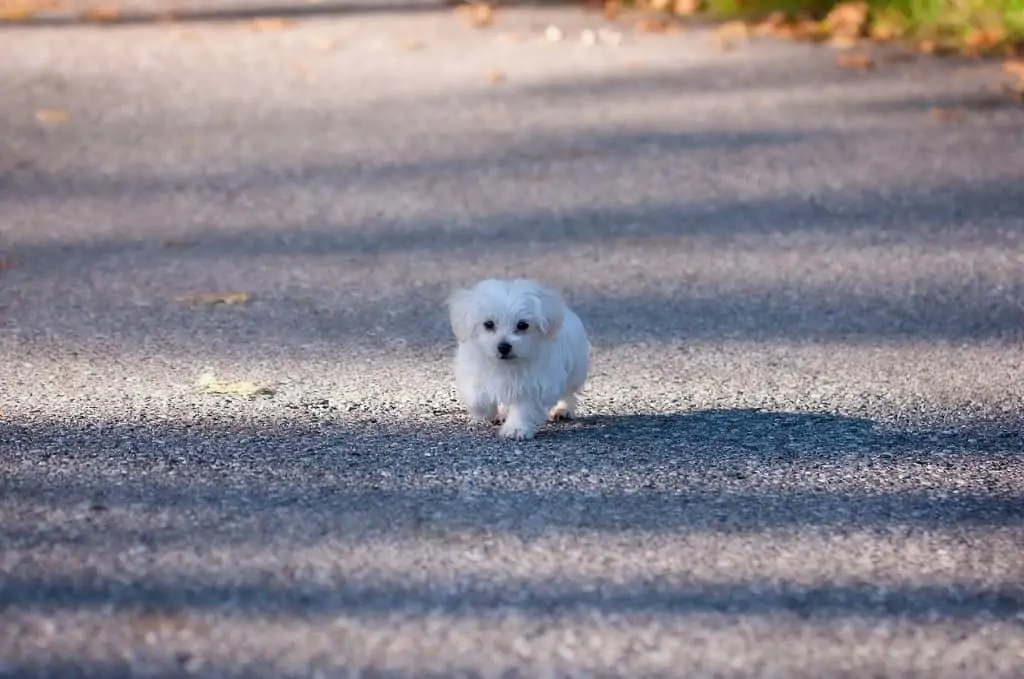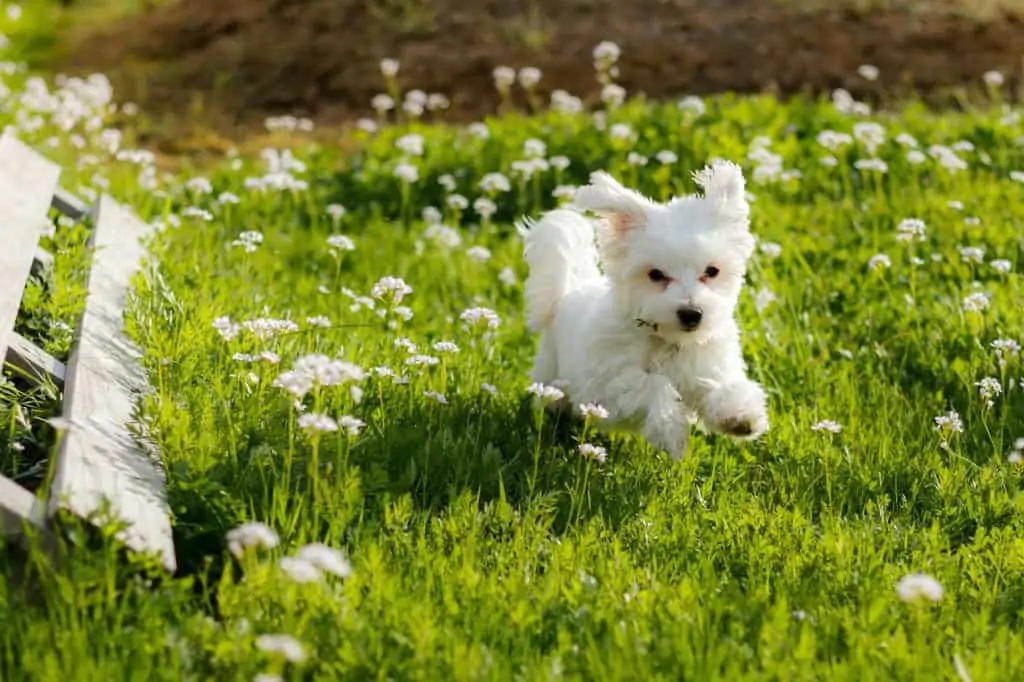The Maltese is already a shining star in the toy dog department, so it’s no wonder we’ve become so smitten with the even smaller version of this adorable breed.
That’s right – the Teacup Maltese is making waves here in the United States, beloved for it’s adoring temperament, gorgeous white coat, and miniature size.
But what happens when an already small dog is bred down to be even smaller? Is this safe, and what should you know before you get a Teacup Maltese?
That’s what we’re here to find out.
Contents
Meet The Teacup Maltese
The Teacup Maltese is not an official size variety of the Maltese breed.
Height: Under 7 Inches
Weight: 3 to Five Pounds
Temperament: Affectionate, Intelligent, Outgoing, Friendly
Best Suited For: Singles, Seniores, Retirees, Families with Older Children, Those With Flexible Schedules
Health Issues: Patent Ductus Arterioles, Luxating Patella, Shaker Dog Syndrome, Deafness, Gastrointestinal Issues, Tracheal Collapse, Heart Murmurs, Enlarged Heart, Cardiomyopathy, Dental Disease, Periodontal Disease, Deciduous Teeth, Overcrowded Teeth, Soft Spots In The Skull, Hydrocephalus, Enlarged Skull, Seizures, and Blindness
Lifespan: 12 to 15 Years
Average Cost: $750 to $2,000
Clubs That Recognize the Teacup Maltese: None
Overview:
The Teacup Maltese is not an official size variety of the Maltese dog, which means this version is not recognized by most major breed clubs. For this reason, a Teacup Maltese is not eligible for show and cannot be registered by the American Kennel Club.
Still, that hasn’t stopped this pint-sized pup from growing in popularity, and it is true that owning a Teacup Maltese has its fair share of pros. Smaller dogs do great in apartments, for example. They are easier to travel with and sometimes less expensive to care for when it comes to food and supplies.
Of course, the Teacup Maltese isn’t right for everyone. Breeding and selling a Teacup Maltese can be somewhat controversial, especially considering this little dog comes with a good list of serious health issues.
But where did the Teacup Maltese come from? Keep reading to find out.
Where Does The Teacup Maltese Come From?
The Teacup Maltese is a bred down version of the standard Maltese. There are a few different ways breeders can go about breeding a teacup maltese.
Different dogs have been bred and perfected for a variety of reasons throughout history. Many working breeds have served as herding dogs, ranch dogs, guard dogs and more. This is not the case for the prim and proper Maltese.
This tiny white dog was designed thousands of years ago by the dog-loving people of Malta. Maltese dogs were bred for one specific task – to be adored by their people. Lap dogs through and through, Maltese dogs are hypoallergenic, famous for their silky coats, and highly affectionate.
As such, these dogs make incredible therapy dogs. They are low-maintenance, sweet-natured, and do well with children and other pets.
You may have thought that the Maltese couldn’t get any better, but in a society that loves to miniaturize their pups, you shouldn’t be too surprised that we’ve found a way to shrink this already little dog into an even more pocket-friendly companion.
But why shrink down the Maltese? Though many people may try and say that breeding smaller dogs makes them easier to live with and travel with, the truth is that breeding the already small Maltese into an even smaller dog is more about desire than need.
With that noted, it’s important you consider the implications of miniturizing dogs that are already miniature.
The Truth About Pint-Sized Pups And Controversial Breeding Practices
Teacup Maltese dogs are certainly cute, but they may not always be healthy.
The standard Maltese stands between 7 and 12 inches tall and weighs between four and eight pounds. So how on earth can you make this already small dog even smaller?
Ambitious breeders have found a way. Well, three ways, to be exact.
- Breeding Runts
- Breeding Dwarfism
- Crossbreeding
Breeding dogs down into smaller versions of themselves is nothing new. The Poodle is a great example of a dog that was bred down over a period of time and now comes in three official size varieties.
However, the standard Poodle is a large dog, and breeding him down to a toy dog took generations of careful breeding before these size varieties were accepted by major breed clubs.
When it comes to dogs that are already considered toy breeds, making them even smaller is not only confusing, it’s controversial.
Breeding Runts
Although the term “runt” isn’t widely accepted as an official term in the canine kingdom, we know it to universally mean that a puppy is born significantly smaller and weaker than the rest of his or her littermates.
When a puppy is born small, it is usually due to underlying health issues that it may carry throughout its lifetime. Runts tend to grow up smaller and stay smaller as adults. While this can be a desirable trait for those who love small dogs, it’s important to take into consideration that these dogs may also be more susceptible to developing serious health issues.
Choosing to breed runts not only creates smaller litters, it may also create a litter of puppies that carry those same genetic health issues that led to their parents being so small, leading to expensive and devastating problems for owners down the road.
Breeding Dwarfism
Another way breeders might go about breeding Teacup Maltese dogs is by intentionally breeding dwarfism into their litters. Just as breeding runts can lead to health issues in a Teacup Maltese, so can breeding dwarfism.
Dwarfism can lead to a number of health issues in Maltese dogs including enlarged skull, breathing difficulties, bone and joint issues, spinal issues and more.
Crossbreeding
The last way breeders can go about creating smaller Maltese dogs is to partake in crossbreeding. While crossbreeding itself is also considered controversial, it is perhaps the safest and healthiest way you are going to be able to obtain a Teacup Maltese.
Crossbreeding is the practice of breeding two chosen purebred parents to create a litter of puppies with specific characteristics.
Also known as a hybrid dog, a designer dog and a mixed breed dog, a crossbreed dog may be deemed unpredictable when it comes to temperament, health and physical appearance, especially if it is an early generation crossbreed.
However, it’s also known that crossbreed dogs have the benefit of what is known as hybrid vigor. This is the idea that crossbreed dogs may be healthier than purebred dogs, as they have a wider gene pool and are thus less likely to inherit certain genetic health issues.
On the flip side of this, crossbreed dogs may also have a longer list of health issues to contend with as they are now susceptible to any of the same health issues as both of their purebred parent breeds.
When it comes to a Teacup Maltese mix, there are a few common mixes you might see. These include:
- The Maltese X Chihuahua Mix
- The Maltese X Yorkie Mix
- The Maltese X Toy Poodle Mix
And though crossbreed Teacup Maltese dogs are likely to be healthier than those bred from runts or from dwarfism, there are still going to be health issues you might contend with.
Take a look.
The Health Risks And Lifespan of A Teacup Maltese
All dogs can be prone to suffering genetic health issues, but the Teacup Maltese may be more susceptible than his standard sized counterparts.
Teacup Maltese dogs can have a lifespan of between 12 and 15 years, which is about as long as their standard sized counterparts. However, unlike their standard sized counterparts, Teacup Maltese dogs can be prone to a much longer list of health issues.
These health issues can vary and will depend on a few factors, including whether or not your Teacup Maltese is a crossbreed.
However, for the most part the Teacup Maltese can be susceptible to:
- Patent Ductus Arterioles
- Luxating Patella
- Shaker Dog Syndrome
- Deafness
- Gastrointestinal Issues
- Tracheal Collapse
- Heart Murmurs
- Enlarged Heart
- Cardiomyopathy
- Dental Disease
- Periodontal Disease
- Deciduous Teeth
- Overcrowded Teeth
- Soft Spots In The Skull
- Hydrocephalus
- Enlarged Skull
- Seizures
- And Blindness
To help combat certain health issues in your Teacup Maltese, experts recommend ensuring you go through reputable sources when looking for a puppy or rescue dog. It’s also important to make sure your Teacup Maltese is on a quality dog food specified for his age, weight and activity level.
Like all dogs, Maltese dogs need dog food that contains real meat protein, fatty acids, carbs, vitamins, minerals and contains a good source of water.
Wet dog food is often a great choice for smaller dogs, though it’s also important to consider that small breed dogs like the Teacup Maltese can be prone to a number of dental issues. Dry kibble can help combat tartar buildup and plaque, so we would recommend giving your dog a variety of both wet food and dry dog food to keep them feeling their best.
Along with a proper diet, it’s also important to keep up with routine exercise, a daily grooming routine, and annual vet visits.
Infact, most veterinarians recommend that small breed dogs under the age of 9 be seen at least once a year. Once they are 9, they should be seen for wellness exams twice annually to combat any health problems exasperated by the natural aging process.
If you go through reputable sources to get your Teacup Maltese, you should be able to get paperwork proving your puppy has been screened and cleared of any serious health issues.
For dogs that haven’t been health screened, you have the option of getting your dog health screened with a canine DNA kit.
Having a good idea of what your dog might be susceptible to can help you when it comes to preventative care and ensuring your Teacup Maltese lives his healthiest, happiest life.
The Teacup Maltese Temperament – Is This A Good Family Dog?
Teacup Maltese dogs do well with children, but they can be easily injured if handled too roughly.
The Teacup Maltese is an affectionate dog who adores his family and is relatively go with the flow. This mild mannered pup is happy so long as he’s at your side.
If you’re considering a Teacup Maltese to call your own, it’s important to know that this is a very people oriented dog who becomes incredibly bonded to his family. A bred companion dog, maltese dogs in general can be prone to suffering serious separation anxiety if left on their own for too many hours throughout the day.
These little cuties do best in homes with owners who have a flexible schedule and can either be home often or at least take their dog with them more often than not.
And while the Teacup Maltese can get along well with children and other pets, it should be noted that they are very fragile. Due to their small size, it could be easy for a Teacup Maltese to become seriously injured if handled or played with too roughly.
For this reason, it’s a good idea to not leave your Teacup Maltese alone with smaller children. We also recommend working with youngsters on how to gently interact with this little dog to ensure everyone is getting along safely and happily.
You’ll also want to watch your Teacup Maltese around larger dogs. Teacup Maltese dogs are social and will enjoy playing with other animals, but they can be accidentally injured by larger, more rambunctious dogs.
Otherwise, these guys are friendly and affectionate. They make great apartment dogs and travel companions. They are also great dogs for seniors, retirees, singles and couples.
How To Properly Exercise A Teacup Maltese
Though small, Teacup Maltese dogs still need routine exercise and mental stimulation.
One of the draws of the Teacup Maltese is that his size may mean he needs less exercise than other, large breed dogs. While this is true, it’s also true that all dogs of all sizes require routine exercise each and every day to ensure they are happy and healthy.
Exercise should be implemented for both your dog’s physical health and mental health, which means mental stimulation is equally important to your Teacup Maltese.
These are clever little dogs who enjoy learning. They can also be prone to separation anxiety, as we discussed above, but this can be combated by ensuring your dog is properly exercised and left with plenty to do while you’re away.
When it comes to mental stimulation, we recommend investing in puzzle toys for small dogs. You can also invest in small KONG toys stuffed with peanut butter or treats, which will help keep your pup engaged and distracted.
Zippy Paws Small Dog Puzzle Toy
No products found.
When it comes to small dogs, you’ll want a toy that is safe, plush and interactive. We like this Zippy Paws puzzle toy that works not only to challenge your little dog, but also let them play and have fun at the same time.
If you’re not a fan of the bunnies, you can order this toy in a number of different varieties. It includes giraffes, piglets, raccoons and more.
You can also put together little agility courses inside or outside of your home. Not only will this help keep your Teacup Maltese engaged but also physically healthy.
Exercise is pretty simple when it comes to this tiny dog. Most Teacup Maltese dogs can have their exercise needs met with a simple walk through the neighborhood that’s about 30 minutes a day. They will also enjoy free playtime or games of fetch or chase inside the house.
When you do walk your Teacup Maltese, remember that this is a dog that can be prone to tracheal collapse. It’s therefore important that you walk your Teacup Maltese with the proper walking equipment for small dogs, which would include a harness that does not put pressure on your dog’s throat or trachea.
EcoBark Small Dog Harness
No products found.
The classic small dog harness listed above would be ideal for the Teacup Maltese. This harness is made with mesh and quality materials that are not only more comfortable and safe for smaller dogs, but also environmentally friendly.
The harness comes in a variety of sizes, making finding the right size for your Teacup Maltese easy. It also comes in several colors options.
Socialization and Training A Teacup Maltese – What You Need To Know
Training and socialization should begin at an early age with the Teacup Maltese.
Although the Teacup Maltese is a bred companion dog, he will still need plenty of training and socialization at an early age. Without it, this dog can become anxious, depressed and nervous. This can also lead to a number of behavioural issues like destructive behaviors or fear based aggression.
Begin socializing your Teacup Maltese as early as possible, ideally in puppyhood. Socialization should include introducing your puppy to as many new experiences as possible and working to ensure these first impressions are positive.
Avoid forcing your Teacup Maltese into situations that are frightening for him, and instead encourage him gently using treats and praise.
It can even help to get your Teacup Maltese used to being handled and played with by gentle children at an early age.
Training your Teacup Maltese should also begin early. Teacup Mlatese dogs are eager to please and quick to learn, and they will enjoy training sessions with you that are kept short, gamelike and fun.
Use positive reinforcement during training like treats and praise, and avoid scolding this little dog. He is very sensitive and can shut down if he feels you’re upset with him. Instead, be patient and encouraging.
Additionally, it’s important to use the right treats when training your Teacup Maltese. The best training treats are going to be small, palatable, chewy and very smelly.
Buckley Training Treats
No products found.
We like the above Buckley training treats because they are all natural, grain free, and low calorie. This makes them excellent to feed smaller dogs during training because it won’t load them up on unhealthy ingredients, additives and grains that could exacerbate allergies.
These training treats are also chewy and made with natural chicken, which most dogs love. Of course, if your dog does have food sensitivities or allergies we recommend finding another recipe other than chicken. Poultry has been found to exacerbate allergies, so just keep that in mind.
Grooming A Teacup Maltese – Tools and Tips
The Teacup Maltese is a hypoallergenic dog, which makes him great for those who suffer from allergies.
Grooming a Teacup Maltese is a breeze so long as you keep his coat cut short. Otherwise, their hair can grow out quite long and silky, and if it’s not routinely brushed or managed, it can be prone to mats and tangles.
Because you won’t be able to show or compete with your Teacup Maltese, you would likely opt to keep their hair cut short in a teddy bear trim.
This trim allots for routine brushing about two to three times a week, and bathing once every two weeks or so. When you do wash your Teacup Maltese, be sure to use a dog safe shampoo that will not strip his skin of the natural oils he produces that help to keep his coat healthy.
Teacup Maltese dogs can also be especially prone to tear stains, and special care should be taken to keep their eyes clean and reduce stains and running.
Like all dogs, the Teacup Maltese will need his nails trimmed or ground down regularly to keep them from getting too long and breaking, and his ears should be cleaned regularly to keep ear infections at bay.
Last but not least, try and implement a proper tooth brushing schedule with your Teacup Maltese. Remember, these little dogs can be especially prone to a number of dental issues, and keeping on top of oral health is going to play a major role in your dog’s comfort and quality of life.
Should You Buy A Teacup Maltese? Here’s What The Experts Say
If you have your heart set on a teacup maltese, we suggest making sure you go through reputable sources.
The Teacup Maltese may seem like the perfect puppy pal on paper, but the truth is that there are a lot of pros and cons when it comes to this pint-sized dog. Although they are precious, Teacup Maltese dogs can come with a number of serious health implications, especially if you get them from an irresponsible source.
Is the Teacup Maltese right for you? Before you decide, let’s take a look at the pros and cons.
Pros
- Teacup Maltese Dogs are hypoallergenic, so they are great dogs for allergy sufferers
- They do well with children and other pets
- These dogs are eager to please and easy to train
- They are small and easy to travel with
- Teacup Maltese do great in apartments
- They are very people oriented and enjoy their families
- They make wonderful therapy dogs
- Teacup Maltese dogs are ideal for seniors, singles and retirees
- They require very little exercise
- Grooming a teacup maltese is relatively simple
Cons
- The Teacup Maltese can be prone to a number of serious health issues
- Teacup Maltese dogs are not an official size variety of the Maltese dog
- The Teacup Maltese can be costly when going through a breeder
- Most reputable sources frown upon breeding and selling Teacup Maltese dogs
- The Teacup Maltese could be costly in the long run to owners due to their health issues
- Teacup Maltese can be prone to separation anxiety
- If their hair grows out, they can be prone to matting and may need more consistent grooming
Have you decided you want to get a Teacup Maltese? If so, it’s important to go through a reputable source. Although it is true that breeding Teacup Maltese dogs can be controversial, it is possible to come across reputable breeders if you take the time and look.
We would recommend looking for Teacup Maltese dogs that are bred via crossbreeding. While these dogs will not be purebred Maltese dogs, they are more likely to be healthier.
On average, a Teacup Maltese through a breeder costs between $750 to $2,000. When you do go through a breeder, you should be able to get a certificate of health proving your dog has been screened and cleared of any serious health issues.
A breeder may also be able to give you proof of pedigree and sometimes you’ll be able to meet your puppy’s parents.
Avoid breeders that are not qualified or who do not understand the importance of quality breeding practices. It’s also important to avoid breeders selling Teacup Maltese dogs for much more than average or much less than average.
If you prefer to adopt, you have the option of going through a rescue to adopt a Teacup Maltese. While you likely won’t find a Teacup Mlatese (named that specifically), you can likely find Mlatese dogs that are smaller (usually around four to six pounds), if you take time and look.
There are plenty of rescues throughout the United States that specialize in particular breeds or mixes, and all it takes is a bit of research.
As you likely know, there are several benefits of going through a breeder. Price is one of them, with rescue dogs going for a fraction of the cost of puppies sold through breeders. You might also be able to find a dog that has already been health screened or a dog that has undergone some behavioral testing before being put up for adoption.
So, what do the experts say about the Teacup Maltese?
Most will not recommend the breeding, buying and selling of these little dogs just yet. While they are incredibly cute, they are high-risk dogs when it comes to health implications, which is something you should certainly consider before investing.
What do you think about the Teacup Maltese now that you know more? Tell us your opinion in the comment section below.


Jen Jones is a professional dog trainer and behavior specialist with more than 25 years of experience. As the founder of ‘Your Dog Advisor’ and the ‘Canine Connection’ rehabilitation center, she applies a holistic, empathetic approach, aiming to address root causes rather than merely treating symptoms.
Well known for her intuitive and compassionate approach, Jen adopts scientifically-proven, reward-based methods, encouraging positive reinforcement over punishment. Jen specializes in obedience training, behavior modification, and puppy socialization. Her innovative methods, particularly in addressing anxiety and aggression issues, have been widely recognized. Jen has worked with many of the world’s leading dog behaviorists and in her free time volunteers with local animal shelters and rescue groups.









